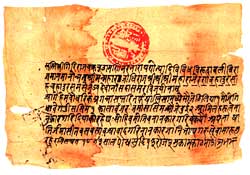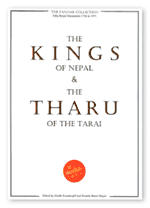 Under oppressive circumstances, it's too frightening to contemplate the gloom that lies ahead. Dreams turn into nightmares. Fear replaces hope. Saving sanity becomes the top priority. In such situations, it's not unusual to fall back upon the glories of an imagined past.
Under oppressive circumstances, it's too frightening to contemplate the gloom that lies ahead. Dreams turn into nightmares. Fear replaces hope. Saving sanity becomes the top priority. In such situations, it's not unusual to fall back upon the glories of an imagined past. The only source of glory of all subject communities in a kingdom is their association with the ruling dynasty. Hence it's not unusual that Tej Narayan Panjiar began to collect Royal Documents to reclaim the honour that was accorded by the rulers of the land to his ancestors.
In Maithil society, Panjiar is traditionally a person who keeps the genealogical records of a particular cast. In this volume, the collector's canvass is much bigger ranging from Vijayapur in the eastern tarai to Binayekpur in the Gorakhpur district of Indian territory. However, the omission of four districts of Naya Muluk (Banke, Bardia, Kailali and Kanchanpur) raises an important question-isn't the present plight of Tharus in this region and their absence of any visible connection with the royal dynasty somehow interrelated?
Land administration in the tarai for the benefit of the rulers is the basic theme of all the lal mohars in the collection. The current Chairman of the Raj Parishad Parshu Narayan Chaudhary is perhaps the first Tharu court noble. The Panjiar Collection gives a glimpse of Tharu history spanning nearly three centuries. No Tharu in that entire period seems to have acquired an office of prominence under any king.
Unsurprisingly, most anthropologists studying Nepal have concentrated their interests on ethnic groups of the hills, valleys and mountains. Academic enquiries aren't as unbiased as they claim to be. It has been in the interest of the ruling class-and their imperial sponsors abroad-to create a body of knowledge about Rais, Gurungs, Magars and Limbus because these valiant tribal groups have traditionally produced cannon fodder. Bahun, Chhetri and Newars had to be studied because they are the ones who have always ruled, and continue to rule, this country. Tarai communities were never considered important enough to deserve special attention, but this book could be a harbinger of change.
 In addition to the names credited on the cover, acknowledgements in the book mentions Mahesh Chandra Regmi, Harka Gurung, Rishikesh Shaha, Prem Khatry, Tirtha Prasad Mishra, Kanak Mani Dixit and Suresh Lama. It's difficult to imagine a more exclusive team of Nepalis to appropriate the history of Tharus for the court in Kathmandu.
In addition to the names credited on the cover, acknowledgements in the book mentions Mahesh Chandra Regmi, Harka Gurung, Rishikesh Shaha, Prem Khatry, Tirtha Prasad Mishra, Kanak Mani Dixit and Suresh Lama. It's difficult to imagine a more exclusive team of Nepalis to appropriate the history of Tharus for the court in Kathmandu. Educated Tharus bemoan the double jeopardy of their community: they are too close to madhesis to be anything else, but too beholden to the court in Kathmandu (due to tenancy relationships) to develop local solidarity. The crisis in Naya Muluk is even more acute where, at present, the security forces consider every Tharu youth to be a Maobadi unless proven otherwise, and the insurgents are so suspicious about cadre there that most militia commanders are from the hills.
This collection succeeds in laying the foundation of future studies by chronicling the glories of the past. The challenge now is to overcome fears and begin dreaming about an inclusive Nepali society where Tharu will cease to be a term of abuse and acquire its rightful place in the polity of the country. (Review by CK Lal)
The Kings of Nepal & the Tharu of the Tarai Edited by Gisele Krasukopff and Pamela Deuel Meyer rusca press and CNAS


